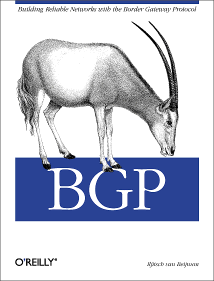
|

|

|
|
Home ·
BGP Expert Test ·
What is BGP? ·
BGP Vendors ·
Links ·
Archives ·
Books ·
My New BGP Book | ||
 (advertisement)
(advertisement)
| ||
Table of contents (for this page):
inet⁶ consultIf you could use some help with BGP, have a look at my business web site: inet6consult.com. BGP routing coursesSeveral times a year I teach a hands-on BGP training course in association with NL-ix. The course consists of a theory part in the morning and a practical part in the afternoon where the participants implement several assignments on a virtual router running the Free Range Routing software. (Based on FRR, a fork of Zebra/Quagga, configured much like a Cisco router.)The next dates are:
Interdomain Routing & IPv6 News
benjojo reports:
At 7AM (UTC) on Tuesday May 20th 2025 a BGP message was propagated that triggered surprising (to many) behaviours with two major BGP implementations that are often used for carrying internet traffic. BGP implementations failing in various ways after seeing something incorrect/unexpected is definitely not a new thing...
NL-ix brings back its famous BGP (Border Gateway Protocol) course. The course is scheduled to happen on October 7. It will be conducted by Iljitsch van Beijnum. In one day (09.30 - 16.00) course participants will learn the internals of BGP protocol. This will help them with a much better understanding of their current BGP work. In English or Dutch depending on the wishes/needs of the participants. More information and registration.
NL-ix brings back its famous BGP (Border Gateway Protocol) course. The course is scheduled to happen on 3rd June. It will be conducted by Iljitsch van Beijnum. In one day (09.30 - 16.00) course participants will learn the internals of BGP protocol. This will help them with a much better understanding of their current BGP work. In English. Hopelijk binnenkort ook weer in het Nederlands. Meer informatie en inschrijven
Last week, Jaap van Till asked me if BGP would be capable of supporting the terabit class interconnectivity that he foresees we’ll need in the future, possibly due to the rise of artificial intelligence. He explains his reasoning in the blog post What Link speeds will we need for AI, where he quotes VAN TILL’s CONJECTURE:
The network connection Wide Area access speed will grow in time until it matches the internal device BUS speed of the more and more complex processors and datastores. And then concludes that 14 Tbps external links will be required in 2039. Today I can get 4 Gbps where I live. So that means a 70% speed increase per year. Let’s first get that BGP question out of the way: I see no problems. 25 years ago I ran BGP over 64 and 128 kbps links without trouble. Six orders of magnitude later, BGP is still fine, and there is no reason to believe that even faster speeds will be a problem, just as long as the packet loss rates remain minimal. But what would terabit class network connectivity at home look like? Actually, I think we have all the parts to build this today. With Wavelength Devision Multiplexing (WDM), it’s possible to transmit multiple data streams through a single fiber by using slightly different wavelengths/frequencies of infrared laser light. Coarse WDM (CWDM) is relatively cheap and appropriate over shorter distances, with 18 wavelengths standardized over high performance fiber. (Fewer over most existing fiber.) For long distances, dense WDM (DWDM) can use as many as 160 wavelengths over a single fiber pair. Bandwidth per wavelength is now 100 or 200 Gbps, and expected to increase in the future. So anything between say 10 x 100 Gbps = 1 Tbps and the 20 Tbps used by modern seacables should be possible. The catch is of course the cost. The difficulty is with the transmitting side, as this requires a tuned laser per wavelength. On the receiving side, the wavelengths can be split using a prism and hit a set of wideband receivers. As someone who is definitely not in the business of building this equipment, it seems to me that a system with one or a small number of transmitters, a passive optical bus, and a large(r) set of receivers is definitely something that could enjoy radical performance vs cost improvements over time. And it fits perfectly with the most efficient / high speed way to connect homes to the internet that we have today: PON (passive optical network). So just add additional wavelengths to existing PON installations to gain more bandwidth in the downstream direction. However, now we have a new challenge: TCP/IP is not a good fit for sending the massive data streams that would make good use of such a network. The problem is that TCP tries to adjust its end-to-end data transmission rate to available bandwidth. This means it needs to wait for acknowledgments from the receiving side to know it can increase its transmission rate, maintain it, or slow the transmission rate down. Downloading 100 MB over a 1 Tbps link takes less than a millisecond. But even over PON, the round-trip-time is a millisecond or two. This means that the bottleneck is the number of round trip TCP requires to reach that full terabit speed. Even if that’s an extremely unrealistic 10 RTTs, that means the total transmission time is now 11 ms, effectively only using a tenth of the available bandwidth. So we need to overhaul TCP/IP for the super high speed stuff and instead use something more like circuit switching / time division multiplexing / token passing. Yes, everything old is new again! So for instance reserve ten 100 μs timeslots and transmit ten 10 MB “megapackets”. So I think all of this is highly doable! Well, there is the slight challenge of how to pipe all that bandwidth into your laptop without connecting/disconnecting that fiber all the time. Maybe use eight Thunderbolt 5 interfaces in parallel to reach 960 Gbps?
Archive of all articles - RSS feed My Books: "BGP" and "Running IPv6"On this page you can find more information about my book "BGP". Or you can jump immediately to chapter 6, "Traffic Engineering", (approx. 150kB) that O'Reilly has put online as a sample chapter. Information about the Japanese translation can be found here.More information about my second book, "Running IPv6", is available here. BGP SecurityBGP has some security holes. This sounds very bad, and of course it isn't good, but don't be overly alarmed. There are basically two problems: sessions can be hijacked, and it is possible to inject incorrect information into the BGP tables for someone who can either hijack a session or someone who has a legitimate BGP session.Session hijacking is hard to do for someone who can't see the TCP sequence number for the TCP session the BGP protocol runs over, and if there are good anti-spoofing filters it is even impossible. And of course using the TCP MD5 password option (RFC 2385) makes all of this nearly impossible even for someone who can sniff the BGP traffic. Nearly all ISPs filter BGP information from customers, so in most cases it isn't possible to successfully inject false information. However, filtering on peering sessions between ISPs isn't as widespread, although some networks do this. A rogue ISP could do some real damage here. There are now two efforts underway to better secure BGP:
The IETF RPSEC (routing protocol security) working group is active in this area. What is BGPexpert.com?BGPexpert.com is a website dedicated to Internet routing issues. What we want is for packets to find their way from one end of the globe to another, and make the jobs of the people that make this happen a little easier.Your host is Iljitsch van Beijnum. Feedback, comments, link requests... everything is welcome. You can read more about me here or email me at iljitsch@bgpexpert. or follow iljitsch on Twitter. Ok, but what is BGP?Have a look at the "what is BGP" page. There is also a list of BGP and interdomain routing terms on this page.BGP and MultihomingIf you are not an ISP, your main reason to be interested in BGP will probably be to multihome. By connecting to two or more ISPs at the same time, you are "multihomed" and you no longer have to depend on a single ISP for your network connectivity.This sounds simple enough, but as always, there is a catch. For regular customers, it's the Internet Service Provider who makes sure the rest of the Internet knows where packets have to be sent to reach their customer. If you are multihomed, you can't let your ISP do this, because then you would have to depend on a single ISP again. This is where the BGP protocol comes in: this is the protocol used to carry this information from ISP to ISP. By announcing reachability information for your network to two ISPs, you can make sure everybody still knows how to reach you if one of those ISPs has an outage. Want to know more? Read A Look at Multihoming and BGP, an article about multihoming I wrote for the O'Reilly Network. For those of you interested in multihoming in IPv6 (which is pretty much impossible at the moment), have a look at the "IPv6 multihoming solutions" page. Are you a BGP expert? Take the test to find out!These questions are somewhat Cisco-centric. We now also have another set of questions and answers for self-study purposes. You are visiting bgpexpert.com over IPv4. Your address is 216.73.216.114. |
